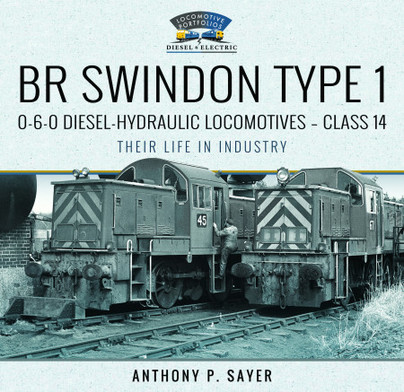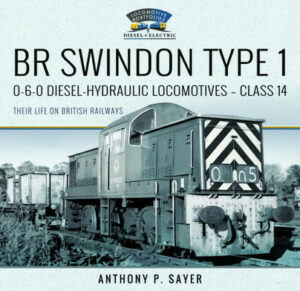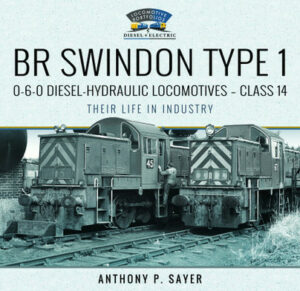BOOK REVIEW – 21-Jun-22 – this week, we include a detailed report by long-term DEPG member and regular contributor Neale Long, who has purchased this newly-released book and reports as follows:
“Continuing with his exploration of the Class 14 history with this second volume, Anthony Sayer takes the story to the end of mainstream operation in industry, in fact to residual operations in 2008/2010. The effective end came with the closure of the National Coal Board (NCB) operations in the North East in 1987. With his usual meticulous research, the author traces the history of the Class commencing with their disposal from British Rail in 1969 to the end of the Class in industrial use in 1987.
Inevitably, the author sought assistance from that reputable and knowledgeable source, the Industrial Railway Society, together with many other sources including the Railway Correspondence and Travel Society and the Locomotive Club of Great Britain. Pleasingly from the Group’s perspective, the booklet ‘Class 14 : The Cinderellas of the Diesel Hydraulic era’ written by John Hembry and published by the D+EG is also recognised in this respect.
In the normal Pen and Sword format, this tome consists of 296 pages, beautifully illustrated with both colour and monochrome images. The book consists of 12 Chapters:
- Introduction – A New Life in Industry
- Locomotive Histories (Industry 1969-1987)
- National Coal Board : Opencast Executive
- National Coal Board : Durham and Northumberland
- National Coal Board : South Wales
- Stewarts & Lloyds / British Steel Corporation (BSC) Corby
- Other Industrial Users
- Success in Industry
- Export
- Preservation
- Further Excursions into Industry (2001-2010)
- Concluding Remarks ending with Sources and References.
The author then proceeds to chart with great clarity and authority all the principal private industrial owners, the NCB Opencast Executive at Crigglestone, APCM at Hope, Westbury (of course !) Gulf Oil Cardiff & Waterston, Shell Haven at ThamesHaven, BP Grangemouth, NCB Ashington and BSC Corby. This clarity and authority is aided by copious use of tables and maps which add greatly to this very well produced volume. The vast majority of the locomotives sold by BR (48 out of 56) ended up at either Ashington or Corby, therefore the main part of this excellent study is dedicated to both those great industrial railway systems which the Class graced.
For the first time, Anthony Sayer comprehensively tells the story of the Class at the NCB and BSC. The chapter on the NCB : Durham and Northumberland is truly eye opening with the amount of detail provided, all backed by some great images of the Class at Burradon, Weetslade, Philadelphia, Ashington and Backworth colliery lines. The chapter on Stewarts and Lloyds / BSC Corby is similarly so, with much information of the operations at Harlaxton, Buckminster, Glendon and Corby quarries again backed by some wonderful images. Those particular chapters are placed into context with chapters charting further excursions into industry ie use in connection with the construction of the Channel Tunnel and a brief chapter touching on the Class in preservation, where they continue to perform well and are popular locomotives on the heritage lines that possess them.
It is worth stressing again that the D+EG/DEPG were the first society to recognise the benefits of the Class and indeed was the first to purchase one for preservation. With the restricted use of ‘Hymek’ D7017 back in those days, D9526 was seen as a workhorse capable of earning funds to assist the Group’s Williton operation. The Group assisted with the privately owned D9551 and a long association between the Class and the West Somerset Railway had begun, an association which continues to this day. With long-term project D9518 now making real progress, this superb volume will further encourage those involved, especially as the locomotive is to be restored to the attractive NCB blue livery.
Locomotives exported abroad remain a source of interest and there’s an interesting chapter on this subject, again placing the industrial story into context. The book’s conclusion ? The Class were a success in industry, principally due to the fact that the Class ended up in the hands of two big concerns with the resources and eventual expertise to operate them. The owners of small fleets of the Class inevitably did not have these benefits.
This is yet another excellent offering by Anthony Sayer on a subject until now largely ignored by the mainstream railway book publishers. This book can be highly recommended to BR traction and industrial railway enthusiasts alike.”
Many thanks to Neale for providing us with this book review.
Click here for the book review covering the first volume.
Buy these books from our online store and support the D9518 Restoration Fund


